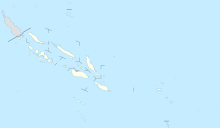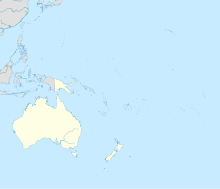
Solomon Islands is a sovereign state in the Melanesia subregion of Oceania in the western Pacific Ocean. This page is about the history of the nation state rather than the broader geographical area of the Solomon Islands archipelago, which covers both Solomon Islands and Bougainville Island, a province of Papua New Guinea. For the history of the archipelago not covered here refer to the former administration of the British Solomon Islands Protectorate, the North Solomon Islands and the History of Bougainville.

The Guadalcanal campaign, also known as the Battle of Guadalcanal and codenamed Operation Watchtower by American forces, was a military campaign fought between 7 August 1942 and 9 February 1943 on and around the island of Guadalcanal in the Pacific theater of World War II. It was the first major land offensive by Allied forces against the Empire of Japan.

Munda is the largest settlement on the island of New Georgia in the Western Province of Solomon Islands, and consists of a number of villages. It is located at the southwestern tip of the western end of New Georgia, and the large Roviana Lagoon is just offshore.

Guadalcanal is the principal island in Guadalcanal Province of the Solomon Islands, located in the southwestern Pacific Ocean, northeast of Australia. It is the largest island in the Solomons by area and the second-largest by population. The island is mainly covered in dense tropical rainforest and has a mountainous hinterland.
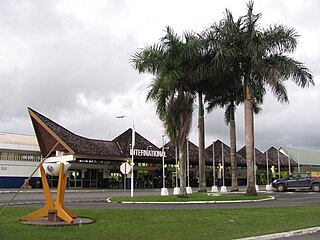
Bauerfield International Airport is an airport located in Port Vila, Vanuatu. The airport is relatively small in size, but its runway has the capability and length to accept jets up to the Airbus A330. It serves as the hub for Vanuatu's flag carrier airline, Air Vanuatu.

Solomon Islands is a country consisting of six major islands and over 900 smaller islands in Melanesia, part of Oceania, to the northeast of Australia. It is directly adjacent to Papua New Guinea to the northwest, Australia to the southwest, New Caledonia and Vanuatu to the southeast, Fiji, Wallis and Futuna, and Tuvalu to the east, and Nauru and the Federated States of Micronesia to the north. It has a total area of 30,407 square kilometres, and a population of 734,887 according to the official estimates for mid 2023. Its capital, Honiara, is located on the largest island, Guadalcanal. The country takes its name from the wider area of the Solomon Islands (archipelago), which is a collection of Melanesian islands that also includes the Autonomous Region of Bougainville, but excludes the Santa Cruz Islands.

The Naval Battle of Guadalcanal, sometimes referred to as the Third and Fourth Battles of Savo Island, the Battle of the Solomons, TheBattle of Friday the 13th, The Night of the Big Guns, or, in Japanese sources, the Third Battle of the Solomon Sea, took place from 12 to 15 November 1942 and was the decisive engagement in a series of naval battles between Allied and Imperial Japanese forces during the months-long Guadalcanal campaign in the Solomon Islands during World War II. The action consisted of combined air and sea engagements over four days, most near Guadalcanal and all related to a Japanese effort to reinforce land forces on the island. The only two U.S. Navy admirals to be killed in a surface engagement in the war were lost in this battle.
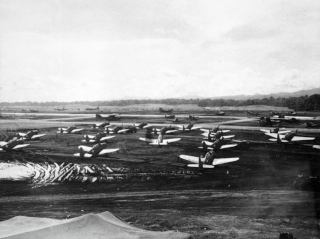
Cactus Air Force refers to the ensemble of Allied air power assigned to the island of Guadalcanal from August 1942 until December 1942 during the most heavily contested phases of the Guadalcanal Campaign, particularly those operating from Henderson Field. The term "Cactus" comes from the Allied code name for the island. In 1943, the Cactus Air Force was absorbed into AirSols, a joint command of Allied air units in the Solomon Islands.

Henderson Field is a public airport located on Sand Island in Midway Atoll, an unincorporated territory of the United States. The airport is used as an emergency diversion point for ETOPS operations. It is one of three airfields named after Major Lofton R. Henderson, together with Henderson Field on Midway's Eastern Island, and Henderson Field in the Solomon Islands. The airfield now provides access to Midway Atoll National Wildlife Refuge.

Henderson Field is a former military airfield on Guadalcanal, Solomon Islands during World War II. Originally built by the Japanese Empire, the conflict over its possession was one of the great battles of the Pacific War. Today it is Honiara International Airport.

Lofton Russell Henderson was a United States Marine Corps aviator during World War II. He commanded Marine Scout Bombing Squadron 241 (VMSB-241) at the Battle of Midway and died while leading his squadron in an attack against Japanese aircraft carriers.
Munda Airport is an international airport adjacent to the town of Munda, Western Province in Solomon Islands.
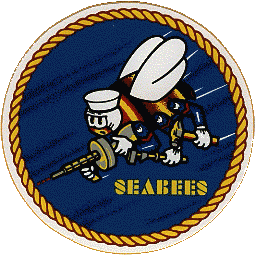
When World War II broke out the United States Naval Construction Battalions (Seabees) did not exist. The logistics of a two theater war were daunting to conceive. Rear Admiral Moreell completely understood the issues. What needed to be done was build staging bases to take the war to the enemy, across both oceans, and create the construction force to do the work. Naval Construction Battalions were first conceived at Bureau of Yards and Docks (BuDocks) in the 1930s. The onset of hostilities clarified to Radm. Moreell the need for developing advance bases to project American power. The solution: tap the vast pool of skilled labor in the U.S. Put it in uniform to build anything, anywhere under any conditions and get the Marine Corps to train it. The first volunteers came skilled. To obtain these tradesmen, military age was waived to age 50. It was later found that several past 60 had managed to get in. Men were given advanced rank/pay based upon experience making the Seabees the highest paid group in the U.S. military. The first 60 battalions had an average age of 37.

Honiara is the capital and largest city of Solomon Islands, situated on the northwestern coast of Guadalcanal. As of 2021, it had a population of 92,344 people. The city is served by Honiara International Airport and the seaport of Point Cruz, and lies along the Kukum Highway.
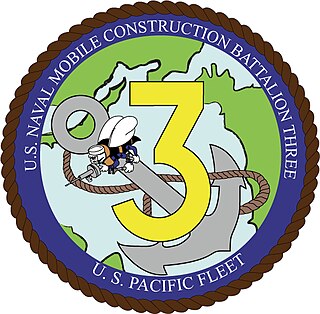
Naval Mobile Construction Battalion THREE is a United States Navy Seabee that was one of the three original Construction Battalions authorized to be formed in 1942. In May 1942 Naval Construction Battalion 3 deployed to the Territory of Hawaii and designated Brigade Headquarters Battalion for the Hawaiian Area NCF. After seeing service in the south Pacific,the battalion was decommissioned mid-1944. In 1950 the battalion was reactivated and today is home-ported at Port Hueneme, California.

Severe Tropical Cyclone Namu was considered to be one of the worst tropical cyclones to impact the Solomon Islands on record, after it caused over 100 deaths within the island nations. It was first noted as a weak tropical depression to the north of the Solomon Islands during May 15, 1986. Over the next couple of days, the storm steadily intensified while meandering. After briefly moving west, the storm attained Category 2 intensity on the Australian intensity scale on May 18, as it moved through the island chain on the next day. Cyclone Namu attained peak intensity of 150 km/h (90 mph). After retaining its peak intensity for a day, Namu turned south and weakened steadily. By May 21, the winds of Cyclone Namu had been reduced to only 80 km/h (50 mph). Continuing to weaken, Namu turned east and dissipated on May 22, away from the island chain.
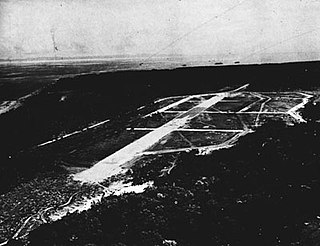
Kukum Field also known as Fighter 2 Airfield is a former World War II airfield on Guadalcanal, Solomon Islands.

US Naval Advance Bases were built globally by the United States Navy during World War II to support and project U.S. naval operations worldwide. A few were built on Allied soil, but most were captured enemy facilities or completely new. Advance bases provided the fleet with support to keep ships tactically available with repair and supply depots of facilities, rather than return them to the continental United States. Before Japan declared war on the United States the U.S. Navy had a single fleet-sized advanced base in the Territory of Hawaii at Naval Station Pearl Harbor. During the war the U.S. Navy Seabees built over 400 advance bases categorized by size. Naval bases were either Lions or Cubs while airfields were either Oaks or Acorns. Lions and Oaks were major facilities while Cubs and Acorns were minor. PT Boats typically would get a Cub and airfields with single runways were Acorns. The larger bases could do refueling and overhaul; loading of troopship and cargo ships; and preparing amphibious assault ships. Some became major repair depots. The Seabees developed auxiliary floating drydocks were able to repair battle damage and do regular maintenance in the field saving ships trans-pacific trips for repair. A few bases also were developed to be R and R for all U.S. personnel. Most Advance Bases were built by the US Navy's Seabees in Naval Construction Battalions (CBs). At the start of the war civilian contractors were employed in construction. The Seabees in World War II built most of the airfields used by the United States Army Air Forces and United States Marine Corps, as they had the ships and cranes needed to transport the vast amount of equipment needed at the advance bases. The US Army and United States Coast Guard also operated out of many of these facilities. Seabees could build new or repair damaged runways, and with advancements in heavy bomber technology lengthen runways as needed. A few Naval Advance Bases were built for the Korean War and Vietnam War.

Naval Base Saipan or Naval Advance Base Saipan or Naval Air Base Saipan was a United States Navy Naval base built during World War II to support Pacific Ocean theater of war and the many warships and troops fighting the war. The base was on the island of Saipan in the Northern Mariana Islands. The base was part of the Pacific island hopping campaign. The base construction started after the Battle of Saipan ended on July 9, 1944. US Naval Advance Base Saipan was constructed by the Seabees Naval Mobile Construction Battalions. The base was under the Commander Naval Forces Marianas. Saipan is 12 miles (19 km) long and 5 miles (8.0 km) wide. About 70% of the island was sugarcane cultivation at the start of the base construction. At the start of the Battle of Saipan, the island's population had about 30,000 Japanese troops and about 20,000 Japanese civilians. The city of Garapan was the administrative center for the Saipan governmental district.
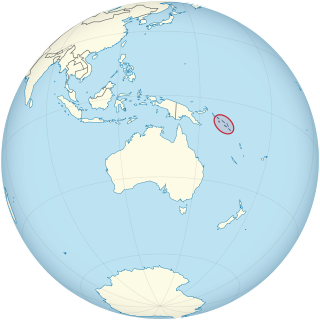
US Naval Base Solomons was a number of United States Navy bases in the Solomon Islands in the Pacific Ocean. Most were built by the US Navy Seabees, Naval Construction Battalions, during World War II as part of the Pacific War. In August 1942 the United States Armed Forces took the Guadalcanal in the Solomon, in the Battle of Guadalcanal. US Navy Seabees built a new base at Guadalcanal, Naval Base Guadalcanal and then on other islands in the Solomons.

